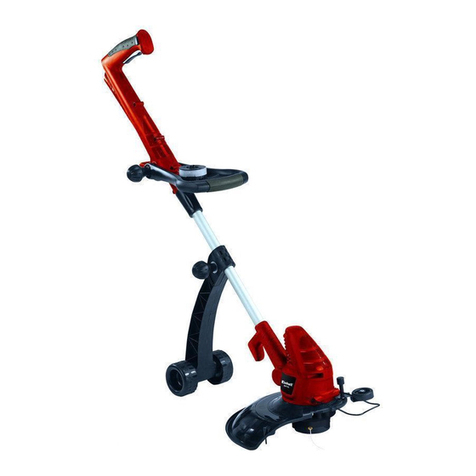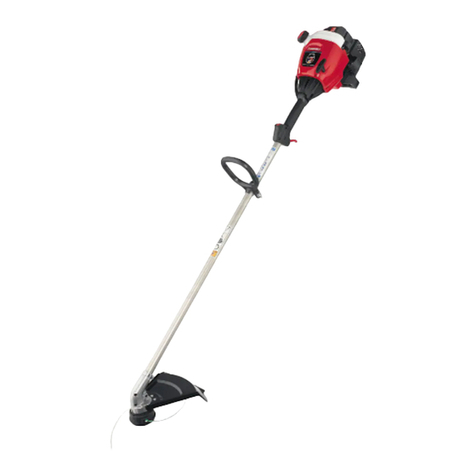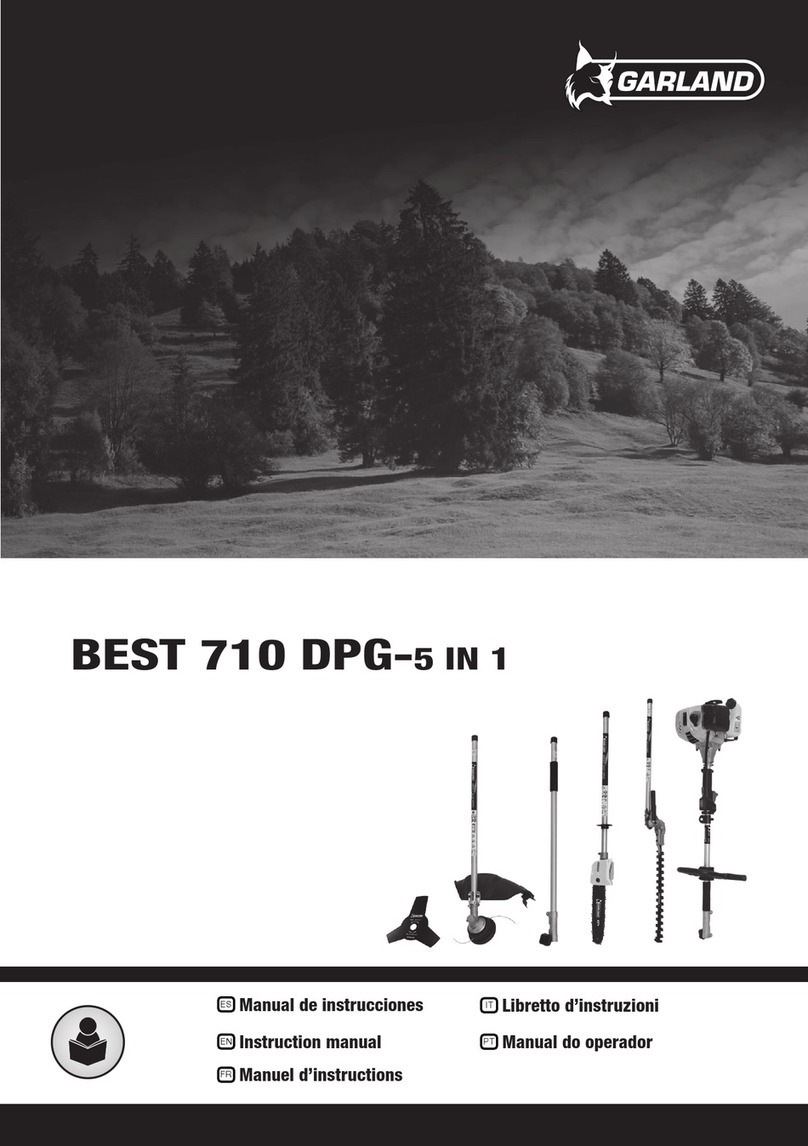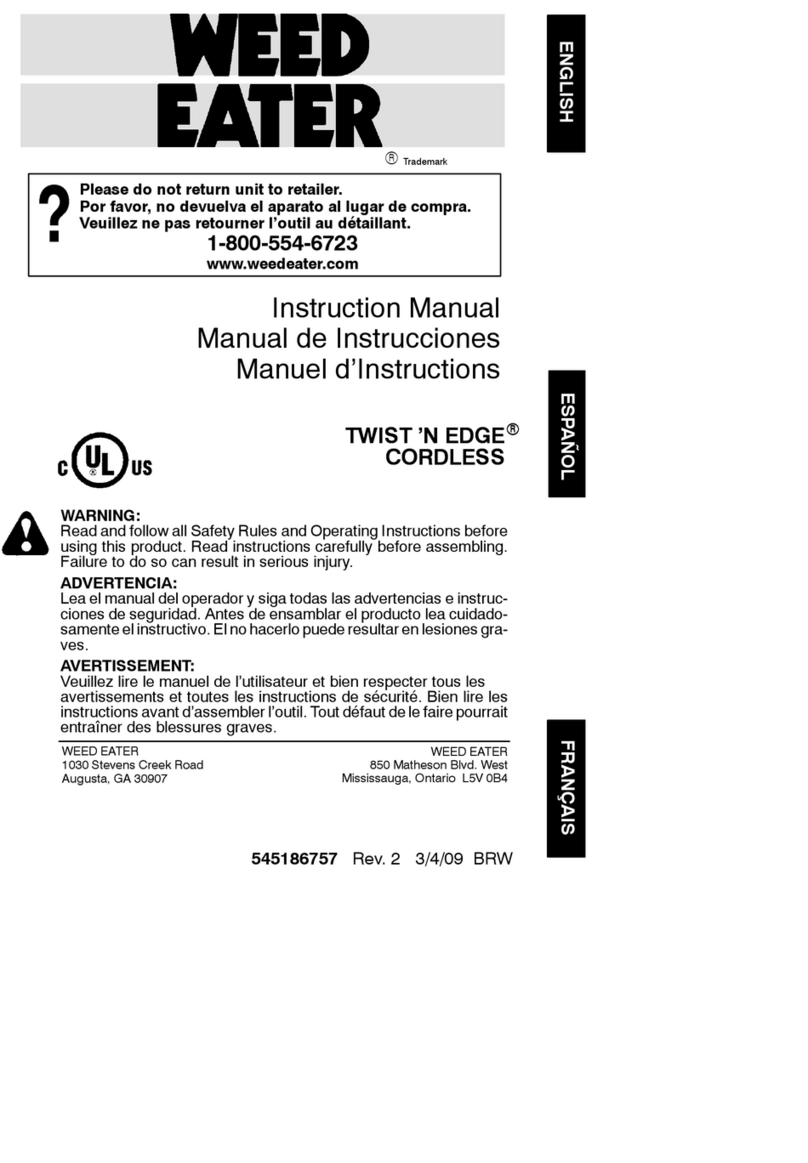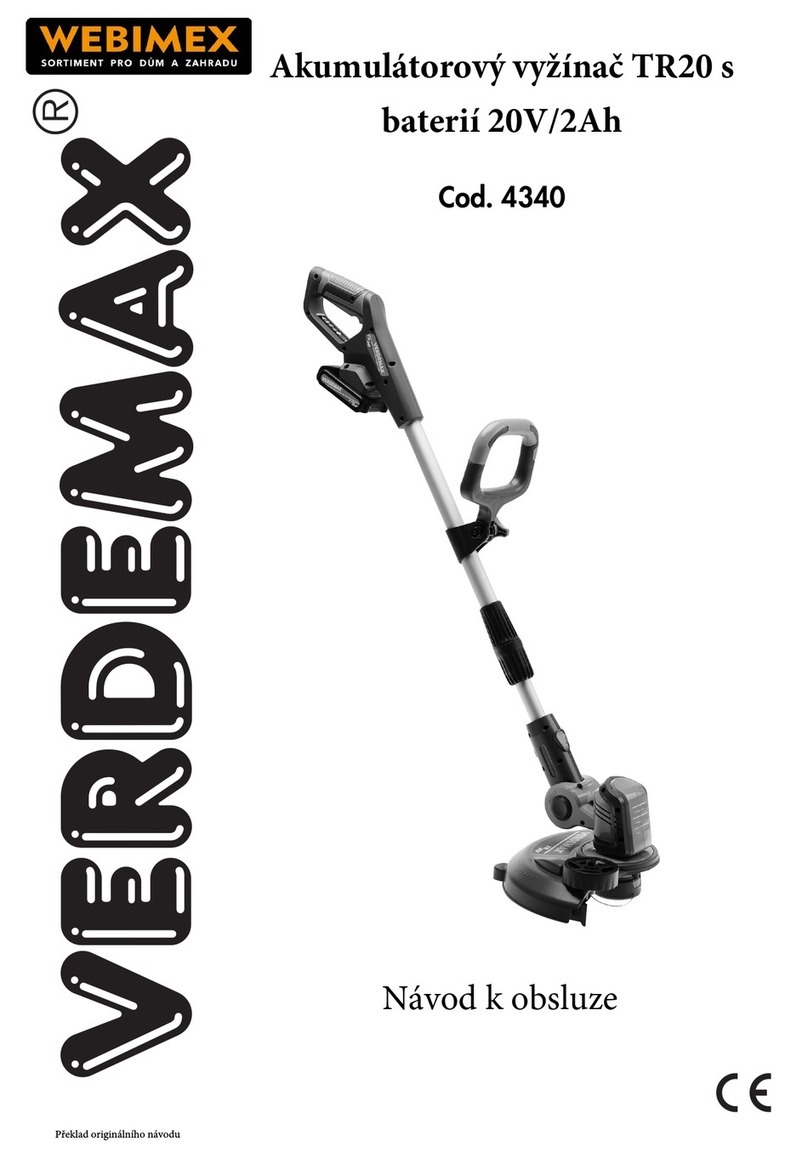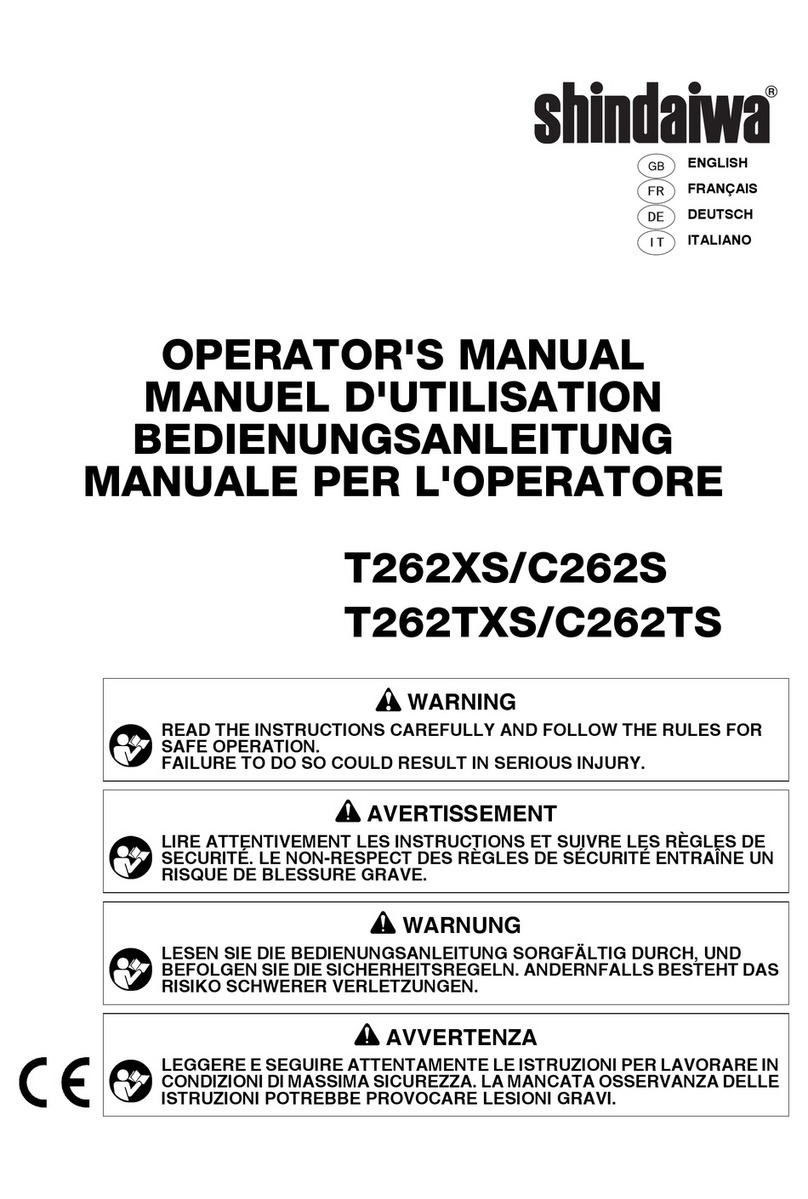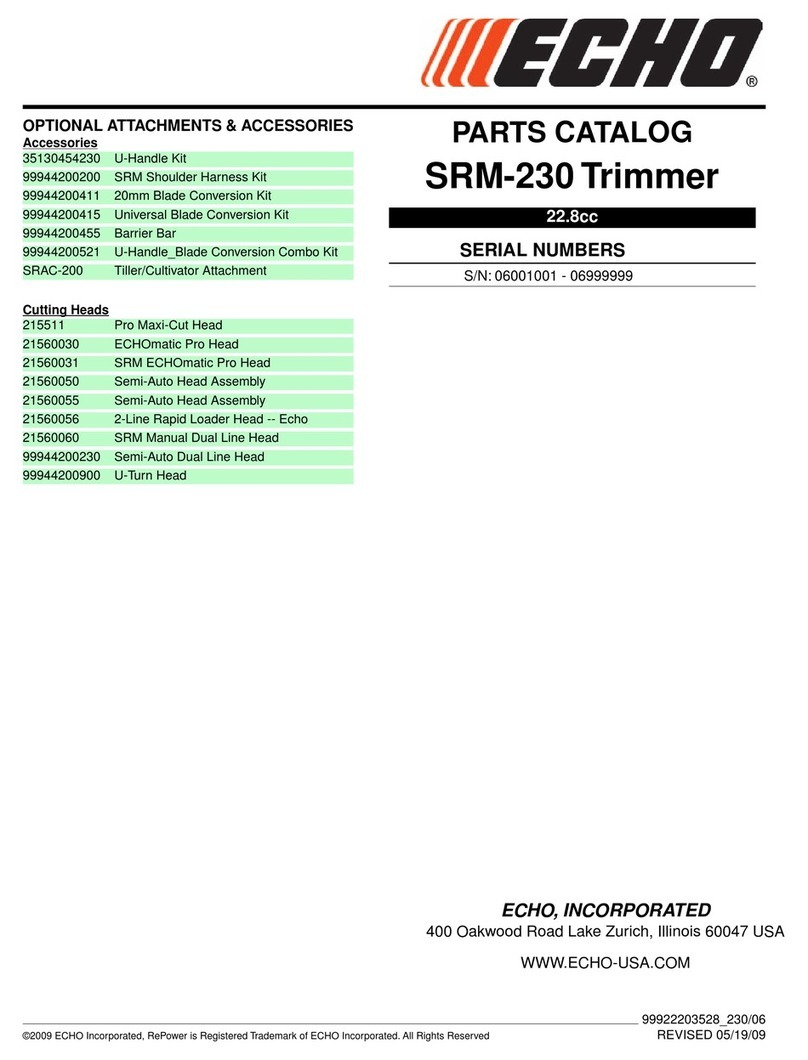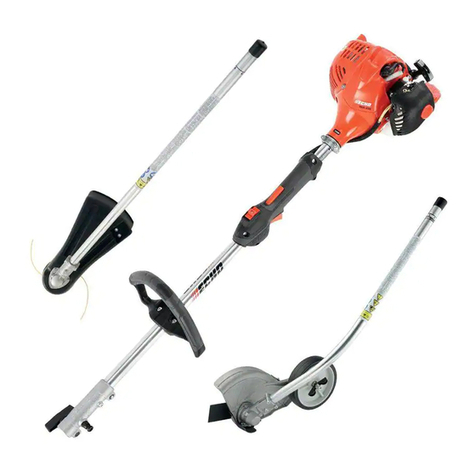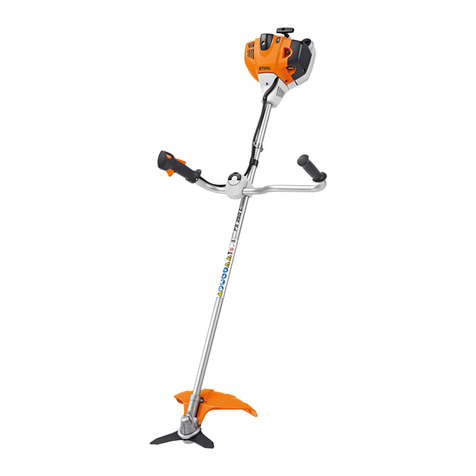CRAFTOP GHT650T User manual

Owner’s Manual
Hedge Trimmer
GHT650T
EXPERTS
IN EQUIPMENTS OF
GARDENING AND AGRICULTURE
ENGLISH
VERSION:02-202106

We thank you for buying CRAFTOP Hedge Trimmer
This hedge trimmer provides advanced technology in incorporating many convenient features for you to perform your
daily cutting work.
Before attempting to use this hedge trimmer, please read this manual carefully until you completely
understand and can follow all safety rules, precautions, operating and maintenance instructions. It will help
you both to become more familiar with this hedge trimmer and to recognize and avoid situations that could endanger
you and others. Careless or improper use may cause serious or even fatal injury!
If you have any question about your hedge trimmer and this manual, please contact your local authorized dealer or
service center. They always welcome your questions, suggestions, and constructive criticism.
We hope you enjoy this hedge trimmer and wish you many years of safe and enjoyable cutting work.
CRAFTOP CANADA LTD.

|-1-
Table of contents
Guide to use this manual .............................................1
Product overview..........................................................3
Technical specification .................................................5
Safety precautions and instructions .............................6
Assembly....................................................................12
Fuel and fueling..........................................................12
Start and stop the engine ...........................................14
Rear handle................................................................ 16
Hedge trimming techniques .......................................17
Maintenance and care................................................19
Storage....................................................................... 23
Disposal......................................................................24
Troubleshooting guide................................................25
Guide to use this manual
This Owner’s Manual refers to a CRAFTOP hedge
trimmer, also called a machine in this Owner’s Manual.
All information, specifications, descriptions and
illustrations in this manual are as accurate as known at
the time of publication, but are subject to change
without notice. Due to ongoing product development,
there may be difference between your machine and the
information in this manual. No legal obligations or
commitments can be delivered from the information,
specifications, descriptions, or illustrations in this
manual.
Illustrations are only for orientation and are merely used
to help explain the text descriptions and instructions.
Illustrations may include optional equipment and
accessories, and may not include all standard
equipment.
Some signs or symbols on the machine may be a little
different refer to special certification requirements for
certain markets.
Any technical modifications to the machine that were
introduced after the editorial deadline please consult
your local dealer for more supplementary information.
All safety precautions and instructions described in this
manual should be observed during operation of the
hedge trimmer, and all applicable federal, state and
local safety regulations, standards, and ordinances
should be observed as well.
Do not sell, lend or rent the machine without this
owner’s manual. Always be sure to include this owner’s
manual together with the machine, and make sure that
anyone using it understands all the information and
follows all the instruction contained in this manual.
Signs and symbols in this manual
DANGER
Texts with this symbol contain information regarding
hazardous situations which will cause death or severe
injures if not avoided.
WARNING
Texts with this symbol contain information regarding
hazardous situations which could cause death or
severe injures if not avoided.
CAUTION
Texts with this symbol contain information regarding
hazardous situations which could cause minor or
moderate injures if not avoided.
NOTICE
Texts with this symbol information regarding situation
which could cause hedge trimmer damage if not
avoided.
information
Texts with this symbol contain supplementary
information.
Read and understand the
Owner’s Manual.
It is very important that you read
this Owner’s Manual carefully,
make sure that you completely
understand and can follow all safety
rules, precautions, operating and
maintenance instructions before
attempting to use this hedge
trimmer, failure to do so may cause
serious or even fatal injury!
Special safety precautions must be
observed when working with this
machine because it has very sharp,
high-speed cutting blades.
Wear proper clothing.
Wear eye, ear and head
protection.
Always wear appropriate personal
protective equipments for hedge
trimmer operation, inclusive of eye
protection, ear protection, and head
protection.
Face mask required.
Operators who are sensitive to dust
or other common airborne allergens
may need to wear a dust mask.
Hands protection.
Always wear appropriate gloves for
hedge trimmer operation.

|-2-
Foot protection required.
Steel toe shoes with anti-slip sole
required in working area.
Fire hazard.
Risk of fire.
Highly flammable material.
No smoking.
Do not smoke in this area.
Sharp edges.
Watch you fingers.
Do not touch the cutting blades
while the engine is running.
Hazards of electric shock.
Be careful of high voltage cable
when you use machine.
Do not touch!
Hot surface.
Do not touch.
STOP
In the event of impending danger or
in an emergency, switch off the
engine immediately by pressing the
engine stop switch backward to
STOP position.
Signs and symbols on the machine
For the purpose of safety operation and maintenance,
the meanings of signs and symbols may be attached to
or embossed on the machine.
The port to refuel mixed fuel with
unleaded gasoline and two-stroke
oil.
Position: Fuel tank cap
Pull the handle to start the engine.
Position: Recoil starter rope handle.
RUN
Set the switch to "RUN" position
when starting the engine.
Position: Top of rear handle.
STOP
Set the switch to "STOP" position,
the engine stops immediately.
Position: Top of rear handle.
Choke control.
Choke closed.
“Cold start” position.
Choke control.
Choke open.
“Run” position.

|-3-
Product overview

|-4-
Index Part Name Description
1 Blade cover Cover cutting blades during transportation or storage.
Remember to remove blade cover before using the machine.
2 Cutting blades Double reciprocating blades mounted to a blade support bar.
The blades are double sided, capable of cutting on either side.
3 Front hand guard A barrel designed to protect the operator’s hand from cutting branches
when holding the front handle to perform trimming work.
4 Spark plug Provides spark to ignite fuel mixture.
5 Choke control lever
Located on the top side of air filter case.
Move choke control lever to “COLD START” position to close the choke
for Cold Starting.
Move choke control lever to “RUN” position to open the choke.
6 Rear handle rotation
release button
Press the button in to release rear handle, then rotate rear handle until the
release button clicks into the next desired position.
7 Engine stop switch
Mounted on the top of the rear handle.
Press switch forward to RUN position, and press it backward to STOP
position.
8 Rear handle
3-position handle can be rotated right or left with 90 degrees, and locked
into each position for a secure grip.
Rear handle contains the engine stop switch, throttle safety lockout, throttle
trigger, and rear handle rotation release button.
9 Throttle trigger safety
lockout
This safety switch must be depressed before throttle trigger can be
activated.
10 Throttle trigger
Throttle trigger safety lockout must be fully depressed before throttle trigger
can be activated.
Throttle trigger controls engine’s speed. It can returns to idle position when
released. Squeeze trigger gradually to obtain a smooth acceleration.
11 Fuel tank A container contains fuel and fuel filter.
12 Fuel tank cap Covers and seals the port for fueling.
13 Purge bulb
Pumping purge bulb before starting engine draws fresh fuel from the fuel
tank, purging air from the carburetor. Pump purge bulb until fuel is visible
and flows freely in the clear fuel tank return line. Pump purge bulb an
additional 4 or 5 times.
14 Air filter A part to cover and hold air filter.
15 Front handle Front handle and rear handle provides the grip for operator to hold the
machine when working with it.
16 Starter rope handle Pull the handle to start the engine.
17 Recoil starter The recoil starter spins the flywheel and crankshaft fast enough to start the

|-5-
Index Part Name Description
internal combustion. When the recoil starter system is engaged, the
operator can crank the engine by hand and get it going fast enough to start.
18 Muffler
A device for reducing the noise emitted by the exhaust of an internal
combustion engine. Its surface may be very hot during or just after
operation.
19 Screwdriver Slot head and Phillips head integrated screwdriver.
20 Combination wrench Combination wrench with size 16mm/19mm for spark plug installation and
disassembly.
21 Open end wrench Metric open end wrench, size is 8mm/10mm.
22 Funnel Easily add mixed fuel to the fuel tank of machine, or add oil into the fuel
mixture container.
23 Fuel mixing container There are two parts of the container, the large part is for gasoline and small
part for engine oil.
24 Hex key 3# Hex key size is 3mm.
25 Hex key 4# Hex key size is 4mm.
26 Owner’s manual An instructional book that is supplied with this machine.
Technical specification
MODEL GHT650T
Item Description Unit Specification
Overall
Product dimension (L x W x H) inch/mm 43.3x9.4x9.4/1100x240x240
Package dimension (L x W x H) inch/mm 45.3x10.2x10.2/1150x260x260
Gross weight lbs/kg 17/7.7
Net weight lbs/kg 12.1/5.5
Engine
Type
Air-cooled single cylinder two-stroke
gasoline engine
Displacement cc 22.5
Bore inch/mm 1.3/32
Stroke inch/mm 1.1/28
Power kw/rpm 0.65/7500
Carburetor Diaphragm carburetor
Idle speed rpm 3200±300
Clutch engagement speed rpm 4200±300
Wide open throttle speed rpm 9500±500
Starter Type Recoil starter
Clutch Type Spring clutch
Fuel
Type
Mixture of unleaded gasoline and
two-stroke oil
Gasoline
Unleaded gasoline with minimum
octane 93

|-6-
MODEL GHT650T
Item Description Unit Specification
Oil CRAFTOP oil
Gasoline :Oil ratio 40:1
Fuel tank capacity ml 550
Gear lubrication
Type Lithium based grease
Capacity g 20
Ignition system
Type CDI
Spark plug electrode gap in/mm 0.12~0.2/0.3~0.5
Cutting blades
Type Double reciprocating blades
Pitch in/mm 0.5/12
Blade length in/mm 0.8/21
Cutting length in/mm25.6/650
Blade height in/mm0.098/2.5
Sharpening angle to horizontal ︒40
Maximum cutting diameter
(soft material) in/mm 0.5/12
Maximum cutting diameter
(woody material) in/mm 0.5/12
Noise levels
Equivalent noise pressure level dB(A) 100
Equivalent noise power level dB(A) 100
Vibration levels
Front handle m/s215
Rear handle m/s215
information
Specifications, descriptions and illustrations in this manual are as accurate as known at the time of publication, but are
subject to change without notice.
Safety precautions and instructions
Special safety precautions must be
observed when working with this
machine because it has very sharp,
high-speed cutting blades. Careless
or improper use may cause serious or
even fatal death.
Before attempting to use this hedge
trimmer, please read this manual
carefully until you completely
understand and can follow all safety
rules, precautions, operating and
maintenance instructions.
Safety precautions
WARNING
•
Observe all applicable local safety regulations,
standards and ordinances.
•
If you have not used this type of hedge trimmer
before, have your dealer or other experienced
operator show you how to operate your machine.
•
Because a hedge trimmer is high-speed wood-cutting
tool, some special precautions must be observed to
reduce the risk of accident and personal injury.
Careless or improper use may cause serious or even
fatal injury.
•
The use of this hedge trimmer may be hazardous.
The cutting blade has many sharp edges. If the sharp
edge contacts your body, they will cut you, even if the
cutting blade is not moving.

|-7-
•
The exhaust from this machine may contain
chemicals known by the State of California to cause
cancer, birth defects or other reproductive harm.
•
The noise emitted from this machine may be
restricted to certain times by national or local
regulations.
•
Minors should never be allowed to use this hedge
trimmer. Do not allow other persons near the hedge
trimmer when starting or cutting. Keep bystanders,
especially children, and animals out of the work area.
Keep bystanders, children, and animals a minimum of
50 feet (15m) from the work area.
•
The person who use this hedge trimmer must be in
good physical condition and mental health, and not
under the influence of alcohol and drugs. Never use
this hedge trimmer when you are fatigued, sick, or
upset. If you feel tired, take a break.
•
The components of this machine generate an
electromagnetic field during operation, which may
interfere with some pacemakers. To reduce the risk of
serious or fatal injury, persons with pacemakers
should consult with their physician and the
pacemaker manufacturer before operating this
machine. In the absence of such information,
CRAFTOP does not recommend the use of this
machine by anyone who has a pacemaker.
•
The owner of this machine is responsible for avoiding
injury to third parties or damage to their property.
CAUTION
Prolonged exposure to cold and/or vibration may result
in injury. Read and follow all safety and operation
instructions to minimize risk of injury. Failure to follow
instructions may result in painful wrist/hand/arm
injuries.
Raynaud’s Phenomenon may affect the fingers of
certain individual if a person is exposed to vibration and
cold. Exposure to vibration and cold may cause tingling
and burning sensations, followed by loss of color and
numbness in the fingers. The following precautions are
strongly recommended:
•
Keep your body warm, especially the head, neck,
hands, wrists, ankles and feet, ,.
•
Maintain good blood circulation by performing
vigorous arm exercises during frequent work breaks.
•
Limit the hours of operation, have a rest when you
feel tired or fatigued.
•
If you experience discomfort, redness, and swelling of
the fingers followed by whitening and loss of feeling,
consult your physician before continuing exposing
yourself to cold and vibration.
Overusing the muscles and tendons of the fingers,
hands, arms, and shoulders may cause soreness,
swelling, numbness, weakness, and extreme pain in
those areas.
•
Avoid using your wrist in a bent, extended, or twisted
posture. Instead, try to maintain a straight wrist
position. Also, when grasping, use your whole hand,
not just the thumb and index finger.
•
Take periodic breaks to minimize repetition and let
your hands have a rest.
•
Reduce the speed and force with which you do the
repetitive movement.
•
Do exercise to strengthen your hands and arm
muscles.
•
Immediately stop using the machine and other power
tools, and consult a doctor if you feel tingling,
numbness, or pain in the fingers, hands, wrists, or
arms.
DANGER
All over head electrical conductors and communications
wires can have electricity flow with high voltages. This
machine is not insulated against electrical current.
Never touch wires directly or indirectly, otherwise
serious injury or even death may result.
DANGER
Do not operate this machine indoors or in inadequately
ventilated areas. Engine exhaust contains poisonous
emissions and can cause serious injury or death.
Clothing and PPE
WARNING
Most hedge trimmer accidents happen when the cutting
blade touches the operator. You must wear proper
clothing and approved personal protective equipments
(PPE) whenever you use a hedge trimmer.
Wear proper clothing.
Clothing must be sturdy but allow
complete freedom of movement.
Wear snug-fitting clothing, an
overall and jacket combination, do
not wear a work coat.
Avoid clothing that could get caught
on branches or brush or moving
parts of the machine. Do not wear a
scarf, necktie or jewelry. Tie up and
confine long hair with a hair net,
cap, or hard hat for instance.
Wear eye, ear and head
protection.
Always wear appropriate personal
protective equipments for hedge
trimmer operation, inclusive of eye
protection, ear protection, and head
protection.
Face mask required.
Operators who are sensitive to dust
or other common airborne allergens
may need to wear a dust mask.
Dust masks can provide protection
against dust, plant debris, and other
plant matter such as pollen. Make
sure the mask does not impair your
vision, and replace the mask as
needed to prevent air restrictions.

|-8-
Hands protection.
Always wear heavy-duty work
gloves made of durable material
(e.g. leather) for hedge trimmer
operation.
Foot protection required.
Wear sturdy steel toe shoes with
anti-slip soles in your working area.
Personal protective equipments can not eliminate the
risk of injury, but it will reduce the degree of injury if an
accident does happen. Ask your hedge trimmer dealer
for help in choosing the right equipments.
Long-time or continuous exposure to high noise levels
may cause permanent hearing impairment. Always
wear approved hearing protection when operating a
hedge trimmer.
Handle your hedge trimmer safely
WARNING
This hedge trimmer must only be used to trim hedges or
shrubs with thinner branches. Do not use the machine
to cut trees, thick branches, grass, solid metal, sheet
metal, plastic, or any other types of material.
Do not use the hedge trimmer as a lever to lift, move or
break objects, nor lock it on fixed supports.
Under any circumstance, you should not modify the
original design of the hedge trimmer without approval
from the manufacturer. Always use genuine spare parts.
Unauthorized modifications or accessories may lead to
serious or even fatal injury.
Under any circumstance, you should not operate your
hedge trimmer if it is damaged, improperly adjusted or
maintained, or not completely or securely assembled.
Always inspect the hedge trimmer before each use, and
replace the parts immediately if it is worn, loose,
damaged or missing.
•
Always disconnect spark plug wire and place wire
where it can not contact spark plug to prevent
accidental starting when setting up, transporting,
adjusting or making repairs except carburetor
adjustments.
•
Always hold the hedge trimmer firmly with two hands
when the engine is running. Do not operate a hedge
trimmer with one hand. Serious injury to the operator,
helpers, bystanders or any combination of these
persons may result from one-handed operation. The
hedge trimmer MUST be used with two hands!
-
If you are right-hander, place your left hand on the
front handle and your right hand on the rear handle,
with your thumbs and fingers tightly encircling the
handles.
-
If you are left-hander, place your right hand on the
front handle and your left hand on the rear handle,
with your thumbs and fingers tightly encircling the
handles.
•
Operate the hedge trimmer only in a well-ventilated
outdoor area. Never start or run the engine inside a
closed room or building. Exhaust fumes contain
dangerous carbon monoxide.
•
Never operate the machine at night, at times of heavy
fog, or at any other times when your field of vision
might be limited and it would be difficult to maintain a
clear view of the working area.
•
During rain, storms at times of strong or gale-force
winds, or at any other times when weather conditions
might make it unsafe to use this machine.
•
Carefully plan your cutting operation in advance.
Never start cutting until you have a clear work area.
•
Maintain footing and balance at all times. Do not
stand on slippery, uneven or unstable surfaces. Do
not operate the hedge trimmer in odd position or on a
ladder or ladders.
•
Always shut off the engine before putting the hedge
trimmer down.
•
Keep exhaust area clear of flammable debris. Avoid
contact hot surfaces during and immediately after
operation.
•
Use a damp cloth, soft bristle brush, and/or air
compressor (Max 25 PSI) to clear your hedge trimmer.
Do not use a pressure washer to clean hedge trimmer
as the solid jet of high pressure water may damage
parts of the machine.
Maintain in good work order
CAUTION
All hedge trimmer service, other than the items listed in
the maintenance section of this manual, should be
performed by authorized service dealer or competent
hedge trimmer service personnel.
WARNING
Only use high-quality replacement parts in order to
avoid the risk of accidents and damage to the power
tool. If you have any questions in this respect, consult

|-9-
an authorized dealer or service center. CRAFTOP
recommends the use of genuine spare parts. They are
specifically designed to match your model and meet
your performance requirements.
•
To reduce the risk of injury, always shut off the engine
before carrying out any maintenance or repairs or
cleaning the machine, only excepts carburetor and
idle speed adjustments.
•
Check the machine for loose/missing nuts, bolts, and
screws. Tighten and/or replace as needed.
•
Check that the cutting attachment is firmly attached
and in safe operating condition. Dull, loose or
damaged blades should not be used.
•
Do not turn the engine over on the starter with the
spark plug boot or spark plug removed since there is
otherwise a risk of fire from uncontained sparking.
•
Check fuel system for leaks due to fuel tank damage,
especially if the machine is dropped accidently. If
damages or leaks are found, do not use the machine
any more, otherwise serious personal injury or
property damage may occur. Have your machine
repaired by an authorized dealer or service center
before using.
•
Check the fuel filler cap for leaks at regular intervals.
•
Check the engine oil level is located at the proper
position.
•
To reduce the risk of fire, do not service or store your
machine near open flames.
•
Use only a spark plug type which is approved by
CRAFTOP and make sure it is in good condition.
•
Inspect the ignition lead (insulation in good condition,
secure connection).
•
Check the condition of the muffler. To reduce the risk
of fire and damage to hearing, do not operate your
machine if the muffler is damaged or missing.
•
Do not touch a the muffler, spark plug, or other
metallic parts of the engine while the engine is
running or immediately shutting down, otherwise burn
injury will result.
•
When planning your work schedule, allow plenty of
time to rest. Limit the amount of time over which the
machine is to be use continuously to somewhere
around 30~40 minutes per session, and take 10~20
minutes of rest between work sessions. Also try to
keep the total amount of work performed in a single
day under 2 hours or less.
Transporting your hedge trimmer
•
When transporting your hedge trimmer by hand, the
engine must be shut off and the cutting blades must
be covered with the blade cover (scabbard) and in the
proper position (for example, grip the top of font
handle, place the muffler and gear housing away from
your body, and the cutting blades to the rear). Avoid
touching hot parts of the machine, especially the
muffler and gear housing, otherwise you could suffer
serious burns.
•
When transporting your hedge trimmer in a vehicle,
the cutting blades should be covered with the blade
cover (scabbard) and properly secured to avoid
turnover, fuel spillage and damage to your machine.
Handle fuel with caution
You hedge trimmer use a gasoline-oil mixture for fuel.
WARNING
Gasoline is an extremely flammable fuel. Pay high
attention when mixing, storing or handling, otherwise
serious personal injury may result.
If spilled and ignited by a spark or
other ignition source, gasoline can
cause fire and serious burn injury or
property damage.
Do not smoke or bring any fire or
flame while handling fuel or while
operating the hedge trimmer. Note
that combustible fuel vapor may
escape from the fuel system.
•
Mix and pour fuel in a well ventilated outdoor area on
bare ground; store fuel in a cool, dry well ventilated
place; and use an approved, marked container for all
fuel purposes. Wipe up all fuel spills before starting
the machine.
•
Eliminate all sources of sparks or flame(i.e. smoking,
open flames, or work that can cause sparks) in the
areas where fuel is mixed, poured, or stored. Always
shut off the engine and allow it to cool down before
refueling.
•
Always use with caution when handling fuel. Wipe up
all spills and then move the hedge trimmer at least
10feet (3 meters) from the fueling point before starling
the engine.
•
To reduce the risk of fire and explosion, fuel your
machine only in a well-ventilated area, outdoors away
from flames, pilot lights, heaters, electric motors, and
other sources of ignition
•
Always shut off the engine before refueling, let the
machine cool down in a non-combustible area, not on
dry leaves, straw, paper, etc. Do not fuel a hot engine
because fuel may spill out and cause a fire.
•
Loose a bit of the fuel cap carefully so as to allow any
pressure build-up in the fuel tank to release slowly
and avoid fuel spillage.. Never remove the fuel cap
when engine is running!
•
If you spill fuel, wipe the machine immediately. If fuel
spills on your clothing, change it immediately.

|-10-
•
Tight the fuel cap securely to the proper position,
make sure it does not loosen or come off due to the
machine vibrations.
•
To reduce the risk of serious or fatal burn injuries,
check for fuel leakage. If fuel leakage is found, do not
start or run the engine until leak is fixed.
•
Do not inhale fuel fumes as they are toxic.
•
Store the machine and fuel in an area where fuel
vapors cannot reach sparks or open flames from
water heaters, electric motors or switches, furnaces,
etc.
Before starting the engine
A area within a minimum radius of 50feet (15m) from
the using the machine should be considered as a
hazardous area, into which on one should enter. If
necessary, yellow warning rope and warning signs
should be placed around the perimeter of the area.
When work is to be performed simultaneously by two or
more persons, special care should also be taken to
constantly look around or otherwise check for the
presence and locations of other people working, so as
to maintain sufficient safety distance between each
person.
Before starting the engine, check that your machine is
properly assembled and in good condition
•
Check the fuel system for leaks, paying high attention
to visible parts such as the fuel tank cap, hose
connections and the manual fuel pump (if equipped).
If there are any leaks or damage, do not start the
engine because of potential risk of fire. Have your
machine repaired by an authorized dealer or service
center before using it again.
•
The engine stop switch must move easily in direction
of STOP position and spring back to the normal RUN
position.
•
Smooth action of throttle trigger lockout and throttle
trigger - The throttle trigger must return automatically
to the idle position by itself.
•
Check that the spark plug boot is secure – a loose
boot may cause arcing that could ignite combustible
fumes and cause a fire.
•
Cutting blades securely mounted and in good
condition (clean, move freely, not warped, properly
sharpened).
•
Check the cutter guard for damage.
•
Never attempt to modify the controls or safety devices
in any way.
•
Keep all handles dry and clean, free from oil and dirt
– for safe control of the machine.
•
To reduce the risk of accidents, do not operate your
machine if it is damaged or not properly assembled.
When starting the engine
WARNING
Note that the cutting blades continue to run for a short
period after you let go of the throttle trigger, due to
flywheel effect.
•
Start the engine at least 10feet (3m) from the fueling
spot, outdoors only.
•
Keep bystanders, especially children and animals at
least 50feet (15m) from the operating point. If you are
approached, immediately stop the engine.
•
This machine is equipped with a centrifugal clutch
mechanism, so the cutting attachments begin to
move as soon as the engine is started by squeeze the
throttle trigger into the start position.
•
Place the machine on firm ground in an open and well
ventilated area. Make sure you have good balance
and secure footing. Hold the machine securely. The
cutting blades must not contact the ground and all
other obstructions because they may begin to run
when the engine starts.
•
Your machine is designed to be operated by one
person only. Do not allow other persons in the work
area even when starting.
•
To reduce the risk of injury, avoid contact with the
cutting blades.
•
Do not drop start the power tool, just follows the way
and start the engine as described in this manual.
•
Never place the throttle trigger into the high-speed
position when starting the engine.
•
Never start the engine by standing on the cutting
attachments side.
•
Check idle speed setting: The cutting blades must not
move when the engine is idling with the throttle trigger
released. If it continues to move even after the throttle
trigger has been completely released, shut off the
engine and take the machine to your authorized
dealer or service center for inspection and/or repair.
information
When a new machine is first operated, in the first few
minutes grease may come out of the gear case. But,
since this is excessive grease, there is no cause of
alarm. Just wipe it off with the engine stopped for next
use.
During operation
WARNING
Moving parts can amputate fingers or cause severe
injuries. Keep hands, clothing and loose objects away
from all moving parts. Always stop engine, disconnect
spark plug, and make sure all moving parts have come
to a complete stop before removing obstructions,
clearing debris, or servicing unit.
Do not touch any moving parts,
especially the cutting blades, while
the motor is running. If the cutting
blades become jammed by thick
branches or other obstructions,
switch off the engine immediately
before attempting to free the blades
– there is otherwise a risk of injury.
To avoid the risk of electrocution,
do not touch electric power lines –
never cut through electric power
lines.

|-11-
Hot surface.
Do not touch.
STOP
In the event of impending danger or
in an emergency, switch off the
engine immediately by pressing the
engine stop switch backward to
STOP position.
•
Always carry related tools, equipments, spare parts,
and consumables with you:
-
Attached tools in the product package.
-
Personal protective equipments.
-
Properly reserved fuel
-
Spare parts (spare blade, etc.).
-
Things to notify your working are (rope, warning
signs, etc.).
-
Whistle (for collaboration or emergency).
-
Hatchet or saw (for removal of obstacles).
•
Check that there are no bystanders, children, and
animals in the general work area. If someone comes:
-
Guard against hazardous situations at all times.
Warn adults to keep children and pets away from
your working area. Be careful if you are approached.
Injury may result from flying debris.
-
If someone calls out or otherwise interrupts you
while working, always be sure to shut off the engine
before turning around. Avoid operating which
people, especially children are nearby.
•
Always be aware of surroundings and stay alert for
possible hazards that you may not hear due to the
noise of the machine.
•
Make sure you always have good balance and secure
footing. Place your feet slightly apart (slightly further
apart than the width of your shoulders), so that your
weight is distributed evenly across both legs, and
always be sure to maintain a steady, even posture
while working.
•
Take special care in slippery conditions (ice, wet
ground, snow), on slopes or uneven ground.
•
Clear away fallen branches, scrub and cuttings.
•
Watch out for obstacles (roots, tree stumps or holes)
which could cause you to trip or stumble.
•
When working at heights:
-
Always use a lift bucket.
-
Never work on a ladder or in a tree.
-
Never work on an insecure support.
-
Never operate your machine with one hand.
•
Watch the cutting blades at all times, do not cut areas
of the hedge that you cannot see clearly. Check the
conditions of working area to avoid any accident by
hitting hidden obstacles, such as stumps, stones,
cans, or broken glass.
•
Be extremely careful when cutting tall hedges, check
the other side of the hedge before starting work.
•
Inspect the hedge and work area to avoid damaging
the cutting blades:
-
Remove stones, rocks, pieces of metal and other
solid objects.
-
When working close to the ground, make sure that
no sand, grit or stones get between the blades.
-
Take particular care when cutting hedges next to or
against wire fences.
•
Make sure the idle speed setting is correct. The
cutting blades must not run when the engine is idling
with the throttle trigger released. If the cutting blades
still run, have your machine checked by an authorized
dealer or service center, to make proper adjustments
or repairs. Check and correct the idle speed setting
regularly.
•
Note that the cutting blades continue to run for a short
period after you let go of the throttle trigger, due to
flywheel effect.
•
The gearbox becomes hot during operation. To
reduce the risk of burn injury, do not touch the
gearbox housing.
•
Be particularly alert and cautious when wearing
hearing protection because your ability to hear
warnings (shouts, alarms, etc.) is restricted.
•
To reduce the risk of accidents, take sufficient break
in good time to avoid tiredness or exhaustion.
•
Work calmly and carefully in daylight conditions and
only when visibility is good. Stay alert so as not to
endanger others.
•
To reduce the risk of serious or fatal injury from
breathing toxic fumes, ensure proper ventilation when
working in trenches, hollows or other confined
locations.
•
To reduce the risk of accidents, stop work
immediately in the event of nausea, headache, visual
disturbances (e.g. reduced field of vision), problems
with hearing, dizziness, deterioration in ability to
concentrate. Apart from other possibilities, these
symptoms may be caused by an excessively high
concentration of exhaust gases in the work area.
•
Operate your machine so that it produces a minimum
of noise and emissions. Do not run the engine
unnecessarily, accelerate the engine only when
working. To avoid noise complaints, in general
operate the machine between 8AM and 5PM on
weekdays, and 9AM to 5PM on weekends, detail
please refer to your local regulations.
•
Do not operate your machine in the starting throttle
position because engine speed cannot be controlled
in this position.
•
To reduce the risk of fire, do not smoke while
operating or standing near your machine. Note that
combustible fuel vapor may escape from the fuel
system. Always clean plant residue, chips, debris,
leaves and excess lubricant off the engine and
muffler. Note that stop the engine before you perform
the cleaning work.
•
If your power tool is subjected to unusually high loads
for which it was not designed (e.g. heavy impact or a
fall), always check that it is in good condition before

|-12-
continuing work. Check the fuel system in particular
for leaks and make sure the safety devices are
working properly. Do not continue operating your
machine if it is damaged. In case of doubt, consult
your local authorized deal or service center.
•
Opening the throttle while the blades are blocked
increases the load and reduces engine speed. The
clutch then slips continuously and this causes
overheating and damage to important components
(e.g. clutch, polymer housing components) –and
this can increase the risk of injury from the cutting
blades moving while the engine is idling.
•
The dust that occurs during operation may be harmful
to health. If dust levels are very high, wear a suitable
respirator.
•
Before leaving the power tool unattended: Shut off
the engine.
•
Check the cutting blades at regular short intervals
during operation or immediately if there is a
noticeable change in cutting behavior:
-
Shut off the engine.
-
Wait until the cutting blades have come to a
complete standstill.
-
Check condition and tightness, look for cracks.
-
Check sharpness.
WARNING
The dust that occurs during hedge
trimmer operation may be harmful
to health. Operators who are
sensitive to dust or other common
airborne allergens may need to
wear a dust mask.
After finishing your work
•
Always clean dust and dirt off the machine. Do not
use any grease solvents for this purpose.
•
Do not use a pressure washer to clean hedge trimmer.
The solid jet of high pressure water may damage
parts of the machine.
Assembly
This model is factory assembled.
WARNING
Always shut off the engine and allow it cool down
before carrying out any work on the hedge trimmer.
Always wear appropriate gloves
when handling the hedge trimmer,
in order to protect your hands from
injury. The cutting blades are sharp
and can cut you even when it is not
moving!
Fuel and fueling
Fuel
WARNING
Gasoline is very flammable. Avoid smoking or bringing
any flame or sparks near fuel. Make sure to stop the
engine and allow it cool down before refueling the
machine. Select well-ventilated outdoor bare ground for
fueling and move at least 3 m (10 ft) away from the
fuming point before starting the engine.
NOTICE
The hedge trimmer is equipped with a two-stroke
engine, and it is certified to operate on unleaded
gasoline and two-stroke air cooled engine oil at a
recommended mix ratio of 40:1. It is important to
accurately measure the amount of oil to be mixed to
ensure that the correct mixture is obtained. When
mixing small amount of fuel, even small inaccuracies
can drastically affect the ratio of the mixture.
40:1
Gasoline: Use good quality unleaded or leaded petrol.
Gasoline may contain up to 10% Ethanol (grain alcohol)
or 15% MTBE (methyl tertiary-butyl ether). Gasoline
containing methanol (wood alcohol) is NOT approved.
•
Poor quality gasoline or oil may damage sealing rings,
fuel lines or fuel tank of the engine.
•
Unleaded gasoline is recommended to reduce the
contamination of the air for the sake of your health
and the environment.
•
The lowest octane recommended is 93. If you run the
engine on a lower octane grade than 93 so-called,
knocking can occur. This gives rise to a high engine
temperature, which can result in serious engine
damage.
•
If you use a gasoline of a Iower octane value than
prescribed, there is a danger that the engine
temperature may rise and an engine problem such as
piston seizing may consequently occur.
•
When working with continuous high speed (e.g.
delimbing), a higher octane grade is recommended.
•
Exhaust emission are controlled by the fundamental
engine parameters and components (for example,
carburetion, ignition timing and port timing) without
addition of any major hardware or the introduction of
an inert material during combustion.
•
Take care when handling gasoline. Avoid direct
contact with the skin and avoid inhaling fuel vapor

|-13-
Two-stroke oil: A two-stroke air-cooled engine oil
meeting ISO-L-EGD (ISO/CD 13738) and J.A.S.O. FD
Standards must be used. Do not use BIA or TCW (2
stroke water cooling type) mixed oil.
•
Never use two-stroke oil intended for water cooled
outboard motors, so-called, outboard oil.
•
Never use oil intended for four-stroke engines.
Mixing
1. Measure out the quantities of gasoline and oil to be
mixed.
2. Put half of the gasoline into a clean container
approved for fuel use.
3. Pour in entire amount of oil and agitate well.
4. Pour in the remaining amount of gasoline and
agitate again for at least one minute. As some oil
may be difficult to agitate depending on oil
ingredients, sufficient agitation is necessary for the
engine to last long. Be careful that, if the agitation is
insufficient, there is an increase danger of early
piston seizing due to abnormal lean mixture.
5. Put a clear indication on the outside of the
container to avoid mixing up with gasoline or other
containers.
6. Indicate the contents on outside of container for
easy identification.
NOTICE
Do not mix more than max. one month’s supply of fuel.
If the machine is not used for some time the fuel tank
should be emptied and cleaned.
Fueling
WARNING
•
Do not smoke or place warm objects in the vicinity of
the fuel.
•
Select bare ground for fueling.
•
Always shut off the engine before refueling the
machine.
•
Move at least 10 feet (3 meters) away from the fueling
point before starting the engine.
Min10ft(3m)
1. Before fueling, clean the filler cap and the area
around it to ensure that no dirt falls into the tank.
2. Loose a bit of the fuel cap carefully so as to allow
any pressure build-up in the fuel tank to release
slowly. Never remove the fuel cap when engine is
running!
3. Put mixed fuel into the fuel tank to 80% of the full
capacity. Make sure the fuel is well mixed by
shaking the container before fuelling. Take care not
to spill fuel while fueling and do not overfill the tank.
4. Tighten the fuel cap securely after fuelling.
5. Wipe up any fuel spillage around the fuel cap and
fuel tank.
CAUTION
Experience indicates that alcohol blended fuels (called
gasohol or using ethanol or methanol) can attract
moisture which leads to separation and formation of
acids during storage. Acidic gas can damage the fuel
system of an engine while in storage. To avoid engine
problems, empty the fuel system before storage for 30
days or longer Drain the gas tank, start the engine and
let it run until the fuel lines and carburetor are empty
Use fresh fuel next season. Never use engine or
carburetor cleaner products in the fuel tank, otherwise
permanent damage may occur.
•
If fuel without mixing of oil (raw gasoline), it will cause
severe damage to the internal engine parts very
quickly.
•
Do not use gasohol, otherwise it can cause
deterioration of rubber and/or plastic parts and
disruption of engine lubrication.

|-14-
•
Do not use 4-cycle engine oil, otherwise it can cause
spark plug fouling, exhaust port blocking, or piston
ring sticking.
•
Mixed fuels which have been Ieft unused for a period
of one month or more may clog the carburetor and
result in the engine failing to operate properly.
•
In the case of storing the product for a long period of
time, clean the fuel lank after rendering it empty. Next,
activate the engine and empty the carburetor of the
composite fuel.
•
In the case of scrapping the used mixed oil container,
scrap it only at an authorized repository site.
NOTICE
If your fuel cap can not be tightened properly, it may be
damaged or broken. Stop using the hedge trimmer and
take it to your authorized dealer or service center for
repair.
Start and stop the engine
WARNING
It is very dangerous to run a hedge trimmer that
equipped with broken parts or lacks of any parts. Before
starting the engine, make sure that all the parts
including cutting blades and blades guard are installed
properly.
WARNING
The cutting blades are very sharp and they will start
moving upon the engine starts. Touching them may
lead to severe personal injury. Avoid touching blades
whenever possible, and always wear gloves to protect
hands.
WARNING
To reduce the risk of serious or even fatal injury:
•
Do not allow children or other unauthorized persons
to attempt to start or otherwise use the machine.
•
Never allow children or unauthorized persons access
to the machine.
•
Never leave the machine unattended while working or
during work breaks
•
After work, store the machine in a safe, secure
location out of the reach of children and other
unauthorized persons
•
Observe safety precautions and instructions.
WARNING
When starting the engine, make sure that your body
does not contact with the muffler. A hot muffler can
cause serious burns.
Start cold engine
WARNING
Before you start the engine, make sure that the cutting
blades are not touching ground or any other obstacles.
CAUTION
The blade cover is used for transportation and storage.
Remove blade cover before using the machine.
1. Fill fuel into the fuel tank and tighten the fuel cap
securely.
2. Press engine stop switch forward to “RUN” position.
3. Move choke control lever upwards to “CLOSE”
position.
4. Pump purge bulb until fuel is visible and flows freely
in the clear fuel tank return line. Pump bulb an
additional 4 or 5 times.
5. Place the machine on a flat and firm ground in a
clear area.
-
Hold the machine firmly with your left hand on the
housing and press down.
-
Put your right foot into the rear handle and press
down.

|-15-
6. Grip the starter rope handle securely with right
hand, and pull it until engine fires (or 5 pulls
maximum).
NOTICE
Do not pull out the starter rope all the way, otherwise it
might break.
Do not let the starter rope snap back by itself. Guide it
slowly back into the housing, so that the starter rope
can rewind properly.
7. After engine fires (or 5 pulls), move choke control
lever downwards to “OPEN” position.
8. Restart engine if necessary and allow the machine
to warm up at idle engine speed for several
minutes.
NOTICE
If engine does not start with choke control lever in
“OPEN” position after 5 pulls, repeat steps 3 ~ 7.
WARNING
The blades must not move at idle speed, otherwise
serious personal injury may result. Periodic carburetor
adjustment may be necessary to assure blades do not
move at idle speed. If blades move, have the carburetor
readjusted by your local authorized dealer or service
center.
NOTICE
When restarting the engine immediately after stopping
it, leave the choke control lever in “OPEN” position.
9. After engine warm-up, grip the front handle and
rear handle firmly. Depress the throttle trigger
safety lockout, and gradually depress throttle
trigger to increase engine RPM to operating speed.
Start warm engine
The WARM starting procedure is almost same as
COLD starting except the choke control lever position,
instead it is starting from “OPEN” position.
NOTICE
When restarting the engine immediately after stopping
it, leave the choke control lever in “OPEN” position.
WARNING
Before you start the engine, make sure that the cutting
blades are not touching ground or any other obstacles.
CAUTION
The blade cover is used for transportation and storage.
Remove blade cover before using the unit.
1. Fill fuel into the fuel tank and tighten the fuel cap
securely.
2. Press engine stop switch forward to “RUN” position.
3. Move choke control lever downwards to “OPEN”
position.
4. Pump purge bulb until fuel is visible and flows freely
in the clear fuel tank return line. Pump bulb an
additional 4 or 5 times.

|-16-
5. Place the machine on a flat and firm ground in a
clear area.
-
Hold the machine firmly with your left hand on the
housing and press down.
-
Put your right foot into the rear handle and press
down.
6. Grip the starter rope handle securely with right
hand, and pull it until engine starts
NOTICE
Do not pull out the starter rope all the way, otherwise it
might break.
Do not let the starter rope snap back by itself. Guide it
slowly back into the housing, so that the starter rope
can rewind properly.
NOTICE
If engine does not start after 5 pulls, use “Start cold
engine” procedure.
WARNING
The blades must not move at idle speed, otherwise
serious personal injury may result. Periodic carburetor
adjustment may be necessary to assure blades do not
move at idle speed. If blades move, have the carburetor
readjusted by your local authorized dealer or service
center.
7. Grip the front handle and rear handle firmly.
Depress the throttle trigger safety lockout, and
gradually depress throttle trigger to increase engine
RPM to operating speed.
Stop the engine
1. Release throttle trigger and allow engine to return
to idle speed for a few minutes.
2. Move engine stop switch backwards to “STOP”
position.
WARNING
If engine does not stop when engine stop switch is
moved to “STOP” position, move choke control lever to
“CLOSE” position to stall engine. Have your local
authorized dealer or service center to repair engine
stop switch before using the machine again.
Rear handle
To reduce fatigue when trimming hedges, this machine
is equipped an angle-adjustable rear handle. It can be
swiveled through 90° to the left or the right. This design
can help you maintain a more comfortable posture
during operation.
WARNING
Always shut off the engine before rotating rear handle
position, otherwise serious personal injury may result.
DANGER
Changing rear handle angle may change exhaust
direction. Make sure to select and use a grip and
operating position that blows exhaust away from you.
1. Move engine stop switch backwards to “STOP”
position.
2. Press rear handle rotation release button to unlock
handle rotation.

|-17-
NOTICE
Throttle trigger must be at idle position in order to press
the rotation lock button.
3. Rotate rear handle to the left until the locking
device clicks into next place.
4. Or, rotate rear handle to the right until the locking
device clicks into next place.
5. Grip the rear, press the throttle trigger safety
lockout lever down with palm of hand and squeeze
throttle trigger to reset rear handle rotation release
button, and lock rear handle in position.
6. When the rear handle is locked in its new position,
you can use the throttle trigger again.
information
If the throttle trigger does not function after rotating rear
handle, move rear handle slightly to left and right until
locking device engages and throttle trigger can be
operated normally.
information
You can swivel the rear handle even with the engine
idling because the hedge trimmer is equipped with a
blade brake that maintains the blades at a standstill.
Hedge trimming techniques
This section describes basic hedge trimming technique
with safety rules for using a hedge trimmer to perform
your trimming work. This information is no substitute for
professional skills and experience. If you get into a
situation where you feel unsafe, stop and seek expert
advice. DO NOT ATTEMPT ANY TASK THAT YOU
FEEL UNSURE OF!
WARNING
Engine exhaust is hot, and it can cause serious burns.
Engine exhaust contains Carbon Monoxide (CO), a
poison gas. Breathing CO can cause unconsciousness,
serious injury, or death. Always position your machine
so that exhaust is directed away from your face and
body.
WARNING
Hedge Trimmer blades are very sharp. Touching them
may lead to severe personal injury. Avoid touching
blades whenever the cutting attachments are moving,
and always wear gloves to protect your hands.
WARNING
Never remove hands from unit when blades are
moving.
WARNING
The engine continues running even when the blades
have stopped due to an obstruction. If this occurs, stop
the engine, disconnect ignition cable and remove the
obstruction.
information
Observe all country-specific or municipal rules and
regulations for trimming hedges.
Do not use your machine during other people's normal
rest periods.
information
Any working position above head height is tiring. To
minimize the risk of accidents, work in such positions
for short periods only.
Trimming sequence
1. Use lopping shears or a chain saw to cut out thick
branches first.
2. Trim both sides of the hedge (Vertical Cut).
3. Trim the top of the hedge (Horizontal Cut).
Vertical cut
1. Always hold firmly the machine with your both
hands
2. Squeeze throttle trigger to accelerate engine.
3. Tilt trimmer so cutting teeth are angled slightly
toward the hedge or shrub and proceed to cut.
4. Swing the cutting blade from the bottom upwards in
an arc – lower the nose of the blade, move along
the hedge and then swing the blade up again in an
arc.

|-18-
Horizontal cut
1. Always hold firmly the machine with your both
hands
2. Squeeze throttle trigger to accelerate engine.
3. Tilt trimmer so cutting teeth are angled slightly
toward the hedge or shrub and proceed to cut.
4. Swing the cutting blade from the bottom upwards in
an arc – lower the nose of the blade, move along
the hedge and then swing the blade up again in an
arc.
5~10
information
In order to get the best trimming results, slightly tilt the
blades 5~10° towards the cutting direction.
information
Always remember to use the tip of the blades to do the
trimming work. You will achieve better results by not
crowding the line into the cutting area. Allow the
machine to rim as its own pace.
information
Trimming slowly, especially with thick hedges.
CAUTION
Avoid to use this machine to cut thick branches, for
which will damage the cutting blades and shorten the
life of drive systems.
Table of contents
Other CRAFTOP Trimmer manuals
Popular Trimmer manuals by other brands
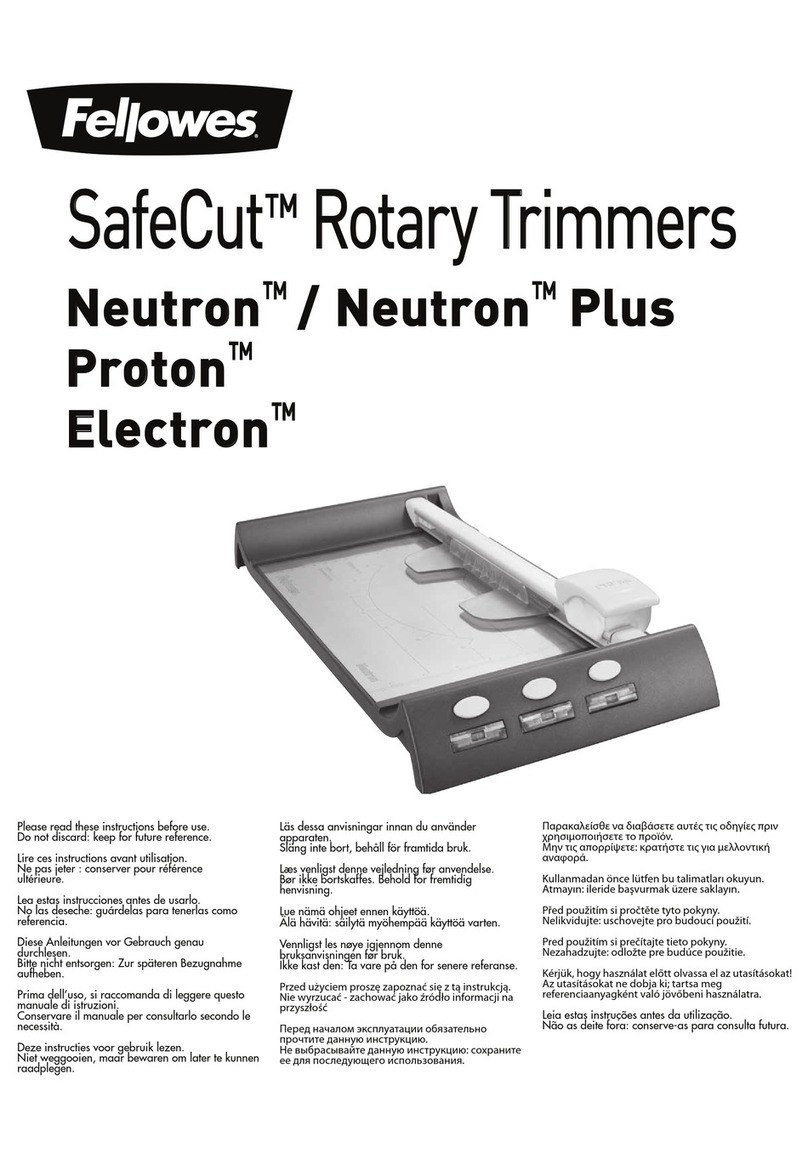
Fellowes
Fellowes SafeCut Neutron plus instructions
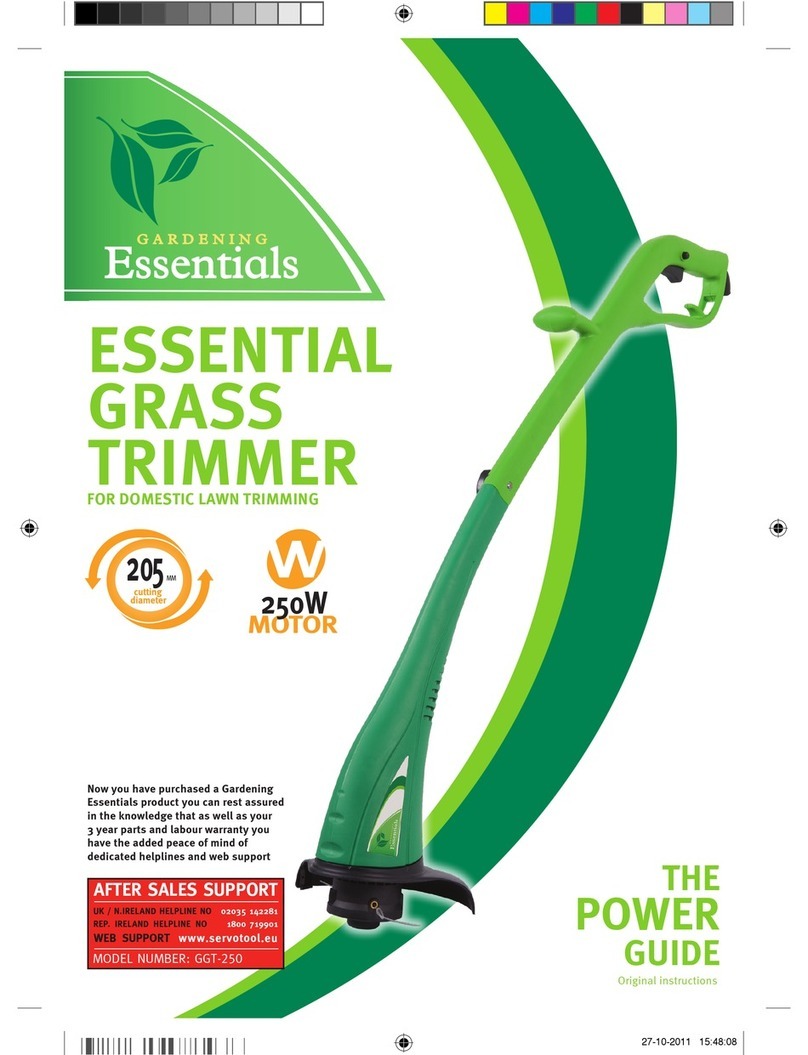
Gardening Essentials
Gardening Essentials GGT-250 Original instructions

GreenWorks Pro
GreenWorks Pro ULTRAPOWER 60V PH60L210 Operator's manual
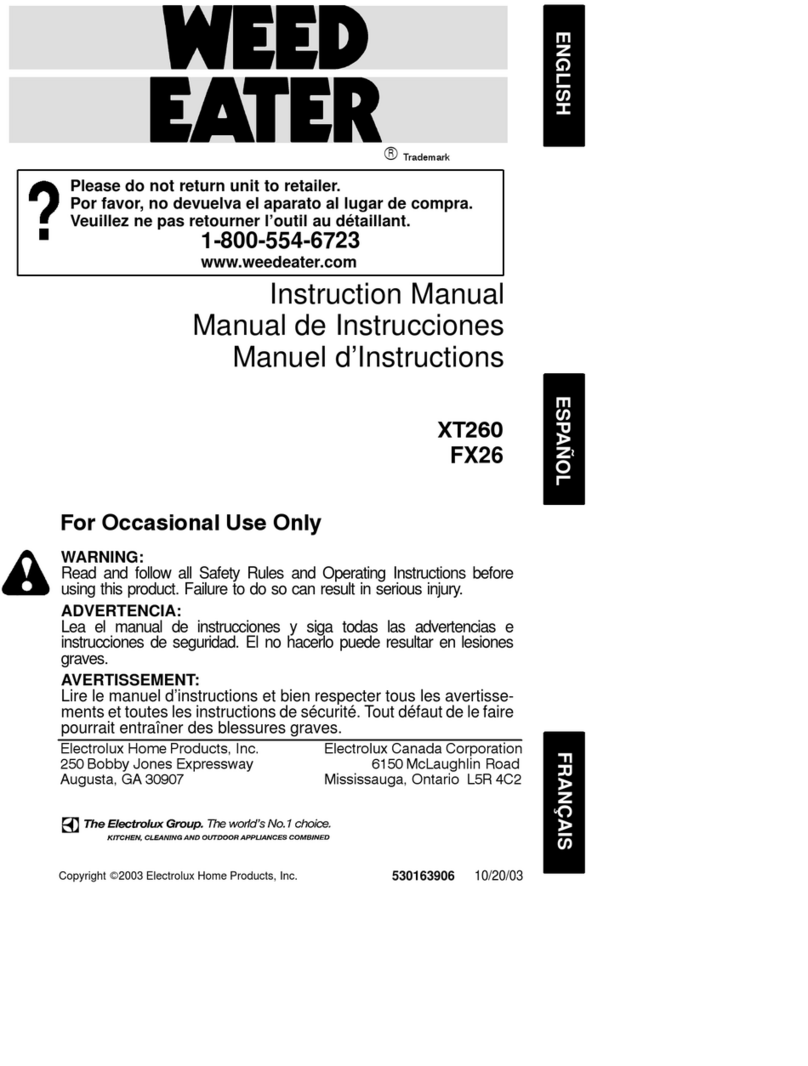
Weed Eater
Weed Eater 530163906 instruction manual

Shindaiwa
Shindaiwa 89310 Owner's/operator's manual
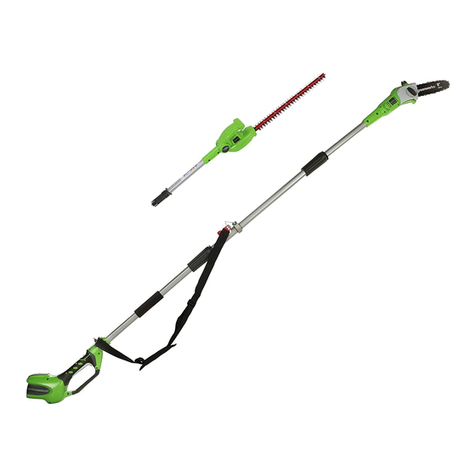
GreenWorks
GreenWorks PSPH40B00 owner's manual

